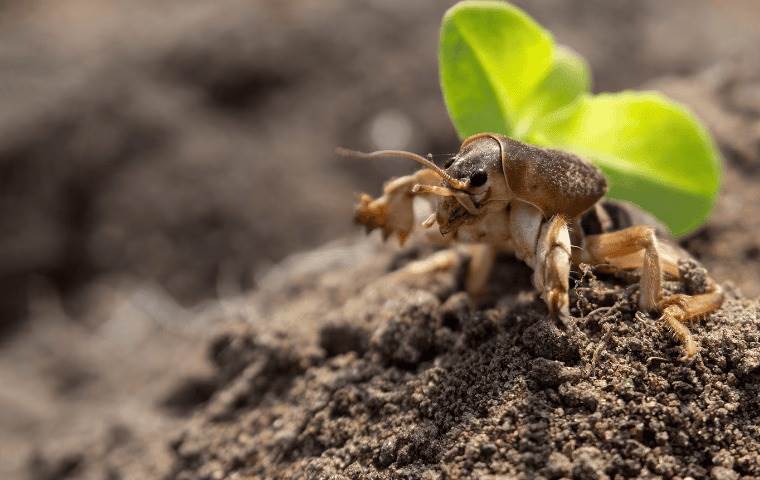
Mole Cricket Identification in Florida
Species Identification And Attribute

The mole cricket is an invasive insect from the family Gryllotalpidae. They get their name because they do kind of look and act like moles! They’re found in various parts of the world, including Europe, Asia, Africa, and in the U.S, they’re common all around Florida and the rest of the Southeast.
Common Species In Florida
Three prominent species of mole crickets can be found in Florida:
- Tawny mole cricket (Neoscapteriscus vicinus)
- Southern mole cricket (Neoscapteriscus borellii)
- Short Winged mole cricket (Neoscapteriscus abbreviatus)
Physical Characteristics
Mole crickets have a number of physical attributes that make them easy to identify. Adult mole crickets have wings and on their front legs have dactyls, or digging claws, that enable them to burrow through soil.
Their bodies are cylindrical and range in length from 1 to 1.5 inches. They have two long cerci extending from their abdomen, which play a vital role in sensory and reproductive functions. Mole crickets also have prominent antennae that help them detect their surroundings.
Life Cycle And Behavior
They have a typical life cycle consisting of eggs, nymphs, and adult stages, and are nocturnal insects.
Eggs are usually deposited in the soil and protected from predators. Nymphs emerge from the eggs and go through a series of molts. During this stage, they look very similar to adult mole crickets, but their wings are not fully developed.
Mole crickets are effective burrowers, creating extensive tunnel systems in the soil. They feed on plant roots, causing damage to various crops and grasses.
Their nocturnal nature and burrowing habits provide them with protection and an optimal environment for feeding and reproduction.
-
Do mosquito control services work?
When you choose to have professional mosquito control performed on your property, you will see a dramatic reduction in the mosquito populations around your yard.
By maintaining monthly treatments, these results will continue. We are so confident in the effectiveness of our mosquito control programs that we guarantee them with free follow-up treatments if needed in-between regular services.
-
How do you control mosquitoes in the yard?
At Native Pest Management, our technicians start their mosquito control service by inspecting your landscape for standing water. We then treat the standing water we find every month with biological larvicides to prevent mosquitoes from breeding.
Then, we perform a pet safe mosquito misting of the landscape to eliminate adult mosquitoes and prevent mosquitoes from finding harborage in your landscape. This guaranteed service should last approximately 30 days.
-
Can pest control get rid of mosquitoes?
No pest control treatment will eliminate every mosquito on your property.
However, with our two-step mosquito control service, we have been told by product manufacturers to expect a 90% reduction in the mosquito population.
Since we believe in the effectiveness of our mosquito control programs, we guarantee them with free follow-up treatments if needed in-between regular services.
Habitat And Distribution
Mole crickets are commonly found in Florida and other parts of the Southeastern United States, such as North Carolina, South Carolina, and Georgia, and even South America.
These insects are known for their unique underground tunneling behavior that allows them to adapt to various environments and soil types.
In Florida, mole crickets are found in sandy soil. By burrowing through the soil, these insects can efficiently move through many square feet in search of food sources and mates, as well as protect themselves from predators.
Their ability to thrive in different soil types also contributes to their widespread distribution.
Impact And Damage
Mole crickets can cause severe damage to turfgrass and lawns. They primarily feed on the roots of various grasses, like the bermuda grass and bahia grass we have here in Florida, leading to weakened growth and eventual death of the turf.
Common signs of mole cricket damage include spongy soil, irregularly shaped patches of yellow or brown grass, and visible tunnels near the surface.
These insects are especially harmful to seedlings and young turfgrass due to their vulnerable root systems. Mature turf may also be affected, resulting in thinned or dead patches. Golf courses, sod farms, and residential lawns are also commonly affected areas.
Like other living species, mole crickets have their fair share of predators. Understanding mole cricket predators can help you maintain mole cricket populations.
Mole Cricket Predators
- Birds such as crows, blue jays, and mockingbirds are known to feed on mole cricket larvae and adults, particularly when the insects emerge at night or after rain showers. These avian predators can dig into the soil to capture mole cricket larvae.
- Armadillos and raccoons both dig into the soil to find mole cricket larvae and adults. These animals actively hunt for mole crickets, however, their digging can sometimes cause additional damage to lawns and crops.
One of the most specialized mole cricket predators is the Larra wasp. This parasitoid wasp specifically targets mole crickets as hosts for its larvae. Female Larra wasps sting and paralyze mole crickets, laying their eggs on the immobilized insects. Once the wasp larvae hatch, they feed on the mole cricket, eventually killing it.
Control And Management
To effectively control and manage these pests, several methods are available, and they can be used in combination.
- Homeowners can make soil less attractive to mole crickets with proper irrigation management. Over-watering can create moist soil conditions that are conducive to mole cricket activity.
- Insecticides and simple fertilization can be an effective option for controlling mole crickets. Liquid insecticides are generally more effective than granular insecticides when the soil is moist and mole crickets are close to the surface.
- Nematodes can also be a useful biological control agent against mole crickets. These microscopic worms can be applied to the affected areas and will infect and kill the mole crickets. This method is typically more effective when used in early summer, as mole cricket nymphs are still small and close to the surface.
- Using a solution of soapy water can help flush out mole crickets from their tunnels, making them easier to spot and target with pesticides. This method, along with natural pest control, can also help homeowners determine the severity of their mole cricket problem.
It is important to begin treatments as soon as mole cricket activity is detected or suspected. Early intervention can prevent the problem from escalating and causing further damage to lawns and gardens.

Why Choose Native Pest Management?
We Exceed Customer Expectations
-
Pet Friendly & Environmentally ConsciousNative Pest Management applies our pest control products with the safety of your family and pets in mind! We also offer eco-friendly pest control to protect your family and the planet.
-
Local Service ProfessionalsSince 2015, we have served communities in West Palm Beach and all throughout South Florida. Our team is fully licensed, insured, and vetted.
-
On TimeOur team will not only arrive on time, but they’ll also go above and beyond when providing service. It’s what makes us one of the top rated pest control companies in Florida! We strive for complete customer satisfaction every time.
-
Get a 100% Free Estimate
Whether you currently have pests in your home or simply want to start professional pest prevention, take the first step to a pest-free life, and contact us today for your free pet-friendly pest control quote.
-
“Warren took his time with the servicing and was very knowledgeable! Exceptional customer service. I will be requesting him each time.”- Montiea Singletary
-
“Excellent service by Chino from Native Pest Management. Chino went above and beyond to make sure we understood everything about the service and kept us very informed during the process.”- Brand Gonzalez
-
“Truly professionals at what they do. very respectful very knowledgeable and great attitude.”- Jorge Acosta
-
“I called and spoke to the manager, who was polite and courteous, and even though it cost them money to come back out and spray, they did not charge me again, and I was very thankful.”- S. Williams
-
“Dale is the absolute best in the business of pests! My sister and I personally ask for him every single time because he always goes above and beyond.”- Zariah Graham
-
“The technician was very professional. He explained things thoroughly and put me at ease with what was about to happen in my home.”- Anthony Diaz
-
“Native pest management always exceeds my expectations! The people who answer the phone are so nice and accommodating and make scheduling a breeze! The techs are always so nice and do a great job.”- Michelle Cato
-
“Extremely impressed with the technicians I met today. Tony and Jamie. Very thorough and customer oriented. I am expecting great things for my trees and plants.”- Curt Kredo

Native Pest Management's Blog
Want all the latest news or updates? Browse through our blog to read our most recent posts and featured articles.







